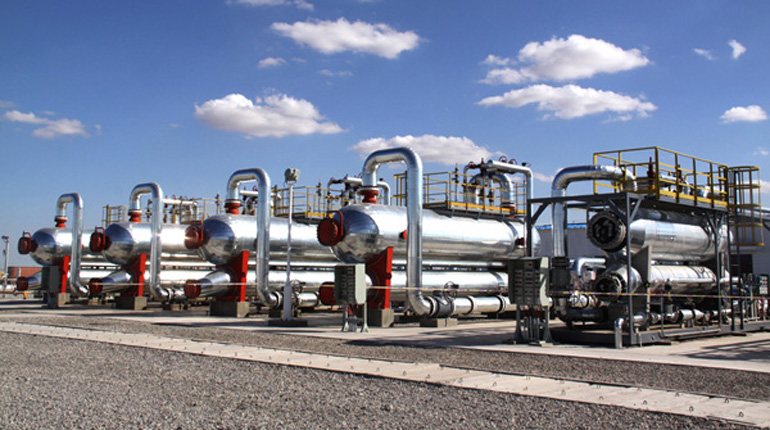 The Amu Darya gas project in Turkmenistan, which feeds China via the Central Asia-China Pipeline. (CNPC)
The Amu Darya gas project in Turkmenistan, which feeds China via the Central Asia-China Pipeline. (CNPC)
The energy landscape of Central Asia has been transformed over the past decade by China’s emergence as a key gas market and the willingness of Chinese state companies and banks to commit tens of billions of dollars to gas development and pipeline projects in the region.
But, with Chinese gas demand slowing down in recent years and state oil giants such as China National Petroleum Corp (CNPC) putting the brakes on their overseas expansion, it is open to question whether this trend will continue. However, industry sources that have been involved in Central Asia and China since the 1990s say it almost certainly will.
"The Chinese remain fully committed to the region and, if anything, their influence is growing. They have strategic objectives and more than enough money to achieve them," said a western oil executive with more than 20 years’ experience of working with China in Central Asia.
The source, who wished to remain anonymous, said Russia – which has seen China usurp its role as the main importer of Central Asian gas – cannot come close to matching the Chinese for financial firepower.
In Kazakhstan alone, there are more than a dozen Chinese oil companies involved in oil and gas production, including CNPC, Citic and Sinopec, while the state-owned China Investment Corp. owns 11% in London-listed Kazmunaigas Exploration and Production, an affiliate of Kazakhstan’s state-owned oil company.
Earlier this year, the state-backed China Energy Fund agreed to buy a 51% stake in Kazmunaigas’s international arm, while smaller Chinese operators, both state-owned and private, have picked up upstream assets in the republic.
"Without the Chinese investment, Kazakhstan would be in a very deep hole. They’re the only ones with money to spend, and they tend to act very quickly," said another western oil executive active in the region, who also wished to remain anonymous
Three years ago, CNPC paid Kazmunaigas $5 billion to acquire an 8.4% interest in the giant Kashagan project, after the Kazakhs had pre-empted a bid by India.
The real game-changer for Central Asia has been the construction of three parallel gas pipelines to China that last year pumped around 30 billion cubic metres of Turkmen gas via Uzbekistan and Kazakhstan to western China.
Pipeline route
The three 1,800 km ‘A’, ‘B’ and ‘C’ pipelines, which are each 50% owned by CNPC under separate joint venture deals with the three transit countries, connect to the giant cross-country network owned by CNPC’s subsidiary Petrochina that runs to the eastern seaboard. With a throughput capacity of 55 bcm/y, the three lines provide China with its largest source of imported gas and will continue to do so for at least the next 10-15 years.
China’s imports of Turkmen gas are underpinned by a long-term sales and purchase contract with state-owned Turkmengaz, which was signed in 2007 and came into force two years later. Around 45%, or 13 bcm/y, of the total volume of Turkmen gas flowing to China comes from CNPC under its production-sharing contract to develop the Bagktyyarlyk area east of the Amu Darya river.
The remaining volumes are provided by Turkmengaz from other onshore fields, of which by far the largest is Galkynysh (formerly South Yolotan). With proven reserves of over 27 trillion cubic metres, Galkynysh has a targeted output of 95 bcm/y.
Underscoring China’s importance for Turkmenistan, CNPC also plays the lead role in developing Galkynysh, while the China Development Bank has provided a $4.1 billion loan to Turkmengaz to help finance the project.
The first phase of Galkynysh was completed in 2013 with the construction of three 10 bcm/y gas processing plants, and a second phase is under way. It is unclear how much of the gas from the field will end up in China – Turkmenisan’s preference is to transport it south to Afghanistan and Pakistan via a new pipeline.
CNPC and Turkmengaz have signed long-term contracts amounting to 65 bcm/y, but to achieve that volume will require building a fourth pipeline. Plans were put in a place for a ‘D’ pipeline that would follow a shorter route to China via Uzbekistan, Kyrgyzstan and Tajikistan, requiring a new set of transit agreements. However, the project’s startup has been delayed, largely because China is not convinced it actually needs the extra gas.
There are plenty of options looking further ahead, not least the 38 bcm/y of Russian gas CNPC is due to receive from Gazprom under a 30-year supply deal that was signed two years ago. There is also the option for the Chinese to ramp up LNG imports, which are set to double from around 20 mt last year to 40 mt by 2020. Chinese gas demand, which rocketed from 34 bcm in 2003 to 167 bcm/y a decade later, has slackened over the past two years in line with the country’s slowing economy.
But there are signs that demand is picking up again. According to official statistics, first quarter imports rose by more than 20% year on year in 2016, to around 20 bcm. And, according to the International Energy Agency, demand is set to rise to 320 bcm by 2021, an increase of 9% per year. So there will continue to be plenty of room for Central Asian gas.








Talk to us
Natural Gas Daily welcomes your comments. Email us at [email protected].